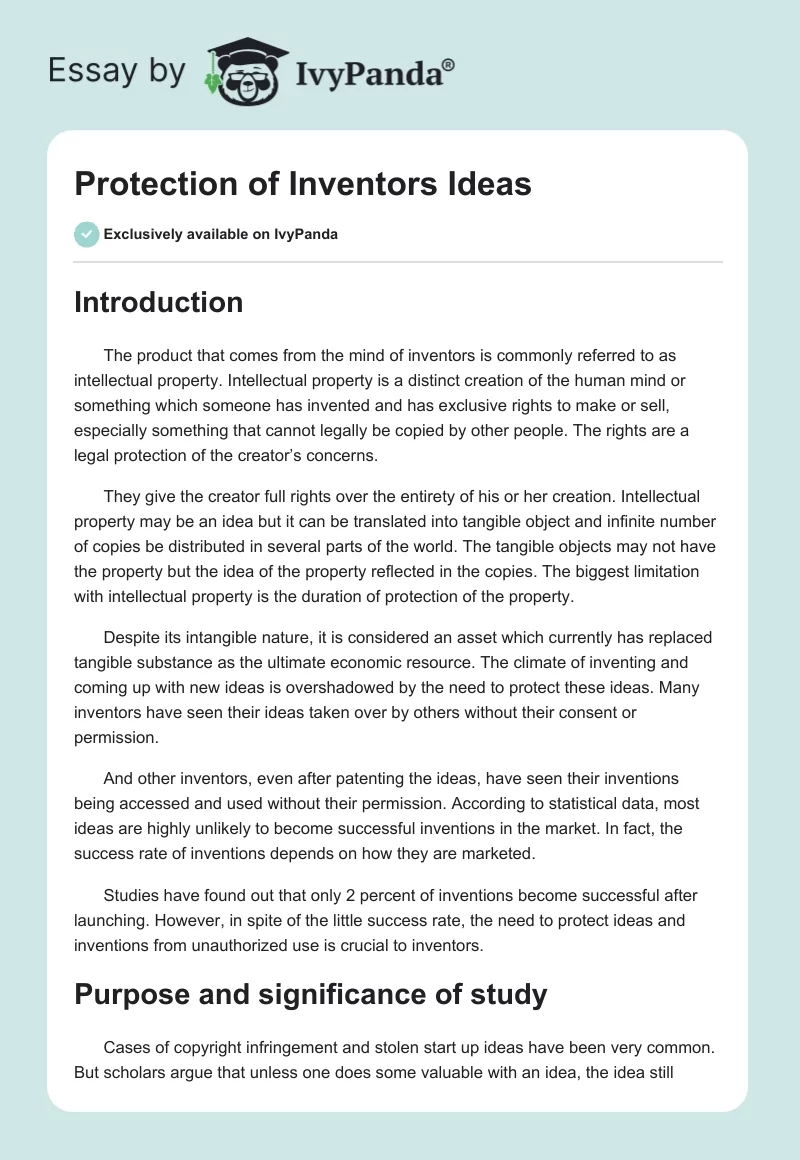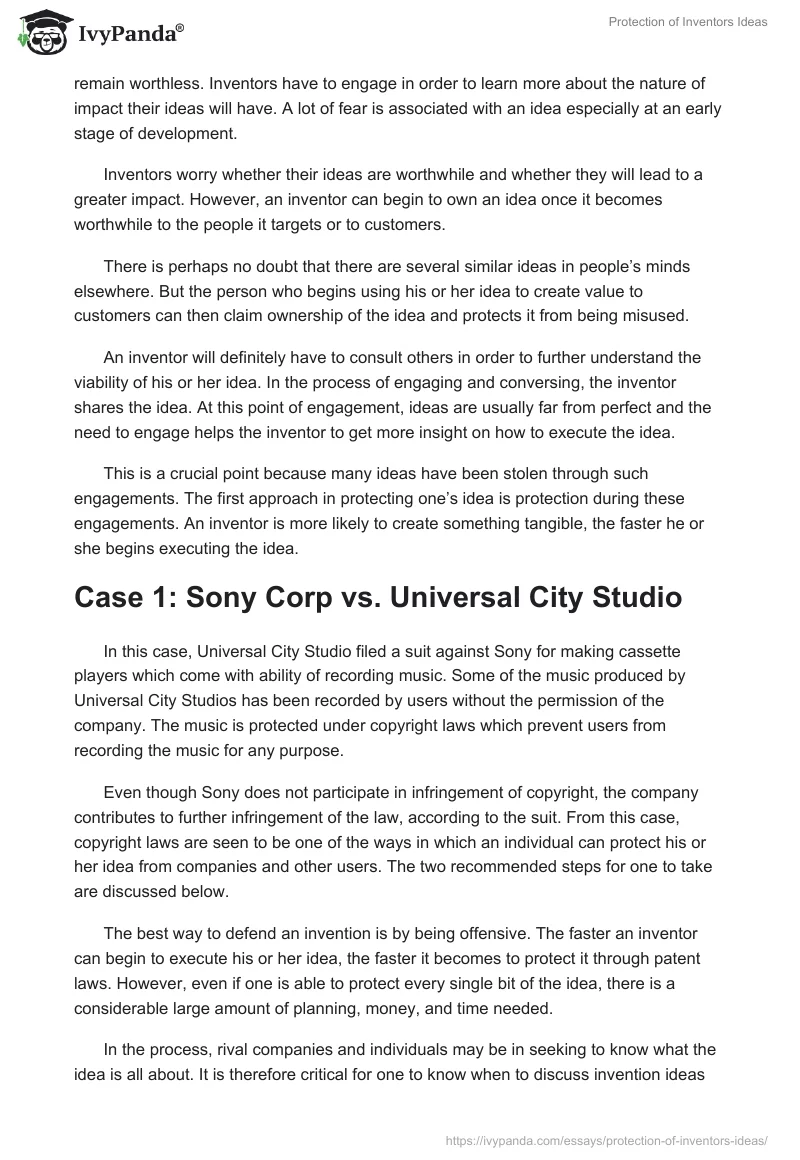Introduction
The product that comes from the mind of inventors is commonly referred to as intellectual property. Intellectual property is a distinct creation of the human mind or something which someone has invented and has exclusive rights to make or sell, especially something that cannot legally be copied by other people. The rights are a legal protection of the creator’s concerns.
They give the creator full rights over the entirety of his or her creation. Intellectual property may be an idea but it can be translated into tangible object and infinite number of copies be distributed in several parts of the world. The tangible objects may not have the property but the idea of the property reflected in the copies. The biggest limitation with intellectual property is the duration of protection of the property.
Despite its intangible nature, it is considered an asset which currently has replaced tangible substance as the ultimate economic resource. The climate of inventing and coming up with new ideas is overshadowed by the need to protect these ideas. Many inventors have seen their ideas taken over by others without their consent or permission.
And other inventors, even after patenting the ideas, have seen their inventions being accessed and used without their permission. According to statistical data, most ideas are highly unlikely to become successful inventions in the market. In fact, the success rate of inventions depends on how they are marketed.
Studies have found out that only 2 percent of inventions become successful after launching. However, in spite of the little success rate, the need to protect ideas and inventions from unauthorized use is crucial to inventors.
Purpose and significance of study
Cases of copyright infringement and stolen start up ideas have been very common. But scholars argue that unless one does some valuable with an idea, the idea still remain worthless. Inventors have to engage in order to learn more about the nature of impact their ideas will have. A lot of fear is associated with an idea especially at an early stage of development.
Inventors worry whether their ideas are worthwhile and whether they will lead to a greater impact. However, an inventor can begin to own an idea once it becomes worthwhile to the people it targets or to customers.
There is perhaps no doubt that there are several similar ideas in people’s minds elsewhere. But the person who begins using his or her idea to create value to customers can then claim ownership of the idea and protects it from being misused.
An inventor will definitely have to consult others in order to further understand the viability of his or her idea. In the process of engaging and conversing, the inventor shares the idea. At this point of engagement, ideas are usually far from perfect and the need to engage helps the inventor to get more insight on how to execute the idea.
This is a crucial point because many ideas have been stolen through such engagements. The first approach in protecting one’s idea is protection during these engagements. An inventor is more likely to create something tangible, the faster he or she begins executing the idea.
Case 1: Sony Corp vs. Universal City Studio
In this case, Universal City Studio filed a suit against Sony for making cassette players which come with ability of recording music. Some of the music produced by Universal City Studios has been recorded by users without the permission of the company. The music is protected under copyright laws which prevent users from recording the music for any purpose.
Even though Sony does not participate in infringement of copyright, the company contributes to further infringement of the law, according to the suit. From this case, copyright laws are seen to be one of the ways in which an individual can protect his or her idea from companies and other users. The two recommended steps for one to take are discussed below.
The best way to defend an invention is by being offensive. The faster an inventor can begin to execute his or her idea, the faster it becomes to protect it through patent laws. However, even if one is able to protect every single bit of the idea, there is a considerable large amount of planning, money, and time needed.
In the process, rival companies and individuals may be in seeking to know what the idea is all about. It is therefore critical for one to know when to discuss invention ideas and with whom to discuss them with. The following are four safe instances available for an inventor to discuss his or her invention. Outside these instances, any discussion may not be considered safe for the idea.
An inventor can discuss invention ideas once he or she has a pending patent status or has already obtained a patent. Secondly, when the execution of the idea requires some sort of partnership, the inventor can go ahead to discuss the idea with the party required.
Thirdly, after signing a non disclosure agreement (NDA) an inventor can freely speak about the idea because NDA bounds the other person from disclosing any information regarding the idea. Lastly, an inventor can discuss invention idea when explaining every detail to a patent attorney.
If an idea is not discussed under these conditions, then most likely its prospects for success can easily be sabotaged. The unfortunate thing is that many inventors are either unaware of these conditions or simply act oblivious to them. They engage in informal conversations with outsiders who end up executing or patenting the ideas before the original owner does.
Patent case: Apple vs. HTC
Apple Inc, a US based smart phone company, has patented many of its products and ideas. However, due to the intense competitions existing in the smart phone industry today, it is likely to find a few infringements of the patents by rival companies.
In 2010, Apple sued HTC for infringing some of its patented intellectual properties. The case came to an end in 2012 with a licensing agreement between the two companies. However, the content of the agreement was never disclosed. This case therefore is the second way by which one can protect his or her idea.
Intellectual property is usually protected from the time it is translated into tangible objects. This however varies with different nations. Protection of intellectual property is valid only within the period that the creator is alive. The original creator usually has a successor. The successor would claim all the economic rights of the property once the original creator dies.
There are also instances where an individual is employed by a company or an organization to invent and create things. Such forms of intellectual property are usually owned by the organization or the employer. The employer would receive all the economic benefits that arise from sales and distribution of the property while the original creator would only gain the moral rights.
The original owner also reserves the right to allow a third party to gain from the economic benefits of his or her property. The third party may be a company that markets and distributes the tangible objects containing the intellectual property however they have to make payments to the original owner in the form of royalties.
Transferability takes two forms, licensing and assignment. In assignment, the third party whom the rights are assigned to becomes the rightful owner of the property and can perform certain acts with it. In the case of licensing, the third party whom the rights are transferred to does not get full ownership of the property.
Conclusion
In conclusion, it is evident that intellectual property has replaced tangible substance as the ultimate economic resource. This has made it an essential asset for inventors to protect from unauthorized use and access through trademarks, patents, and copyright. The need to protect ideas and intellectual property is also important for development of innovation.
Inventors therefore need to be aware of the appropriate mechanism for ensuring that their ideas are not stolen by anyone. This paper has highlighted the various ways in which an inventor can protect his or her idea using two approaches. Copyright, patent, and trademarks are among the ways in which inventors should use to protect their intellectual properties.
Works Cited
Adamson, John E. and Amanda Morrison. Law for Business and Personal Use. New York: McGraw Hill, 2011. Document.
Cheeseman, Henry. Business law, Legal environment, Online commerce, Business ethics and International issues. Upper Saddle River, NJ: Pearson/Prentice Hall, 2010. Document.
Coase, Williams. The Aims of the Law of Tort”, Current Legal Problems. 2nd. Oxford: Hurt Publishing, 2003. Document.
Deakin, T., H. Johnston and N Markesinis. Markesinis & Deakin’s Tort Law. 2nd. Oxford: OUP, 2007. Document.


